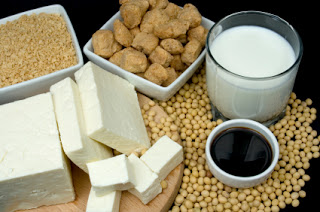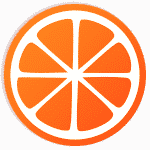 |
| Um, not the most appetizing selection of foods, would you agree? |
I could write about my friends coming over to cook Friday. We made delicious red lentil soup and I learned the most efficient way to cut cauliflower. I also could write about the NYC marathon yesterday (congrats to our Foodtrainers’ clients who completed the race). There are many easier topics to write about than soy but I’ve postponed this doozy long enough. One of my closest friends from the past sent me a note asking “soy -is it good or bad? How much is ok? Is the amount different for men and women? What about little girls?”
To let the “soy” cat out of the bag, I don’t think soy is the wonder substance or cure-all it has been made out to be. The way we eat soy in this country bastardizes how soy was traditionally eaten. This is a blog post and not a research paper so I will tell you my soy questions started in graduate school. One of our teachers, a vegetarian, explained how she had been nicknamed Ms. Tofu (I think that was it) for her love of all things soy. She changed her view after a breast cancer diagnosis and did suspect soy played a role in the development of her disease. This was someone who ate soy immoderately (admittedly) and there is no way to prove the truth of her hypothesis but it definitely made me reevaluate soy and how I eat it and how I suggest others eat it. The isoflavones in soy, genistein and diadzein, are similar to human estrogen and may fuel certain cancer growth in cells with estrogen receptors.
For starters, there are some forms of soy you should avoid. TVP, which stands for textured vegetable protein, soy protein isolates and soy protein concentrates are shoddy, inferior examples of soy. Read your labels and skip foods with these in it. Additionally, do a pantry, fridge and freezer check (Boca Burger or Luna bar anyone?) and toss foods with these ingredients. Soy protein powder, protein bars and faux meats commonly use soy isolates and TVP. These ingredients are also common in fast food and school lunch programs. For those of you who purchased the Skinny Bitch book these items figured prominently in that food plan.
To make soy protein isolates or TVP takes heavy machinery, potent chemicals and leaves behind the fiber and many nutrients found in the original soybean. Additionally there are worrisome levels of certain substances, such as aluminum, left with the soy protein. Think of bathing in toxic bath oil, even once you dry yourself off, some residue remains. Want to eat that residue? Speaking of drying, the spray drying method used for soy forms nitrites. According to the
Cornucopia Institute many processed soy foods, including some “made from organic soybeans” utilize hexane a pollutant and neurotoxin. The cancer connection for processed soy foods is stronger than for traditional whole soy. Processed, mangled estrogen, carcinogens, neurotoxins? Not for my family.
Fermented soy products are probably the best soy foods to consume. Examples of these are miso (delicious), tempeh, natto and soy sauce. Fermentation increases the digestibility of soy and adds “good” bacteria and reduces the plant estrogen content in soy foods. When we look at Asian diets in Japan about half of soy consumption is from fermented soy and the other half tofu and dried soybeans. In China, soy consumption originated when it was discovered how to ferment soy.
In terms of children, I was interested to hear the Israeli health ministry issued an advisory saying babies should not get soy formula and children under 18 should limit soy in their diets. Other countries such as the UK and Australia have soy warnings as well. As with food dyes and many other questionable ingredients, the U.S. says these foods are safe. As far as men, they unknowingly consume soy in many bars, shakes and “muscle building” products. These are concentrated sources of processed soy. Very high soy consumption can affect testosterone, estrogen and thyroid hormone levels as well as iron absorption. For this reason, anyone with a thyroid condition or trying to conceive should, in my opinion, skip soy that is unfermented. Women with breast cancer or at high risk for breast cancer should skip unfermented soy as well.
As far as actionable steps:
- First, take stock of soy’s role in your diet. Look at everything from your bread to your snacks.
- Next, dabble in fermented soy. Natto is not a big part of my diet but I’ll glaze fish or vegetables with miso and my kids love miso soup.
- If you do buy tofu or edamame, look for organic or non GMO (organic assures it’s non GMO) though in some cases it’s hard to know if these are “organic” Chinese soybeans or US organic where standards are actually enforced.
- I’m not convinced you should add tofu or edamame to your diet if it isn’t there already. You want a rule I’d go with eating these foods once a week (max).
- And finally, for new moms reading this, do try to avoid soy formulas.
There are so many angles in the soy discussion that I was forced to simplify things. Let’s see where your questions lie and perhaps we can revisit this topic. In the mean time:
How often do you eat soy? Have you tried miso or tempeh? Do your kids have soy? Would you have rather read about cutting cauliflower?
NYC readers- I’m giving a fun talk at the YinOva Center the evening of Thursday, 11/17, 7pm
Eat, Drink and Be Healthy: The Savvy Girls’ Guide to the Holidays
Call 212-533-2255 to register, bring a “savvy” friend and all your holiday food questions.


